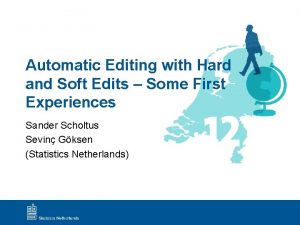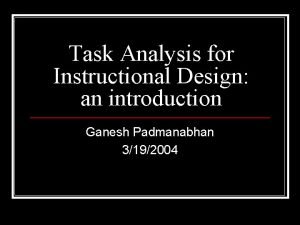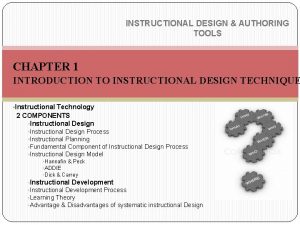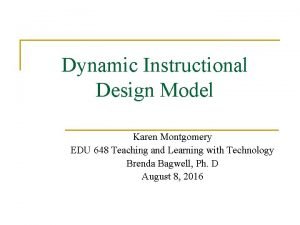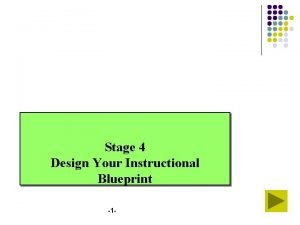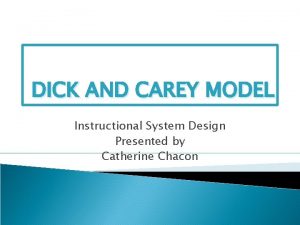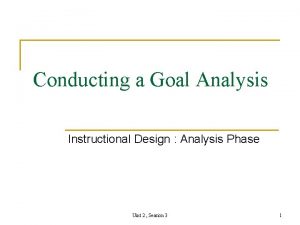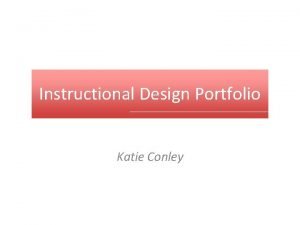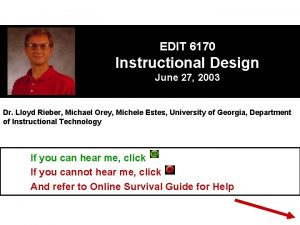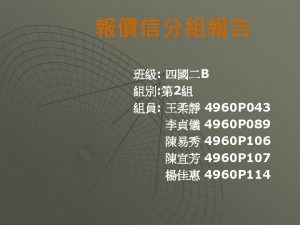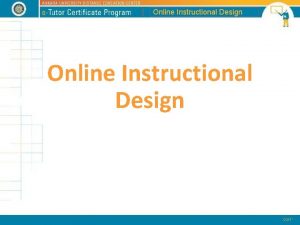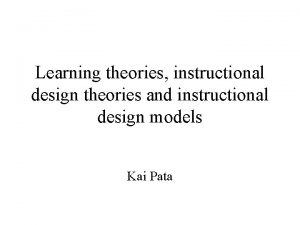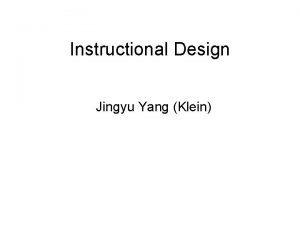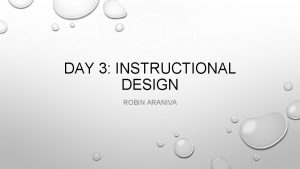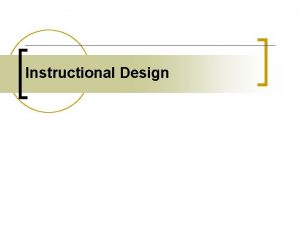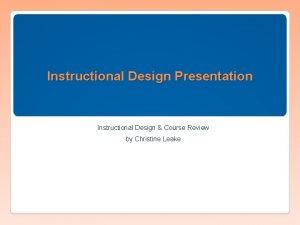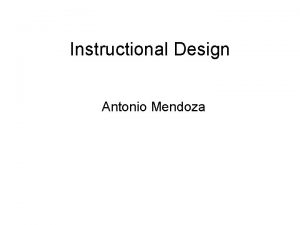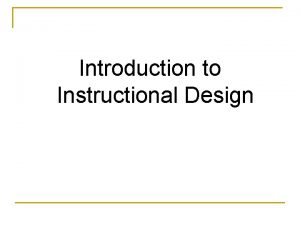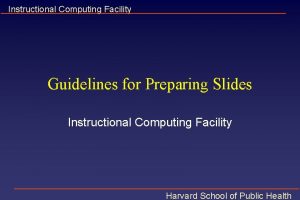EDIT 6170 Instructional Design Refrigerator Slides so important

















- Slides: 17

EDIT 6170 Instructional Design Refrigerator Slides so important they’re worth sticking to your refrigerator! Last updated November 12, 2009

Forming a team • Facts: – At least 2 members, no more than 4 – At the lesson level, each team must develop and evaluate as many lessons as there are team members – Otherwise, project is the same in scope for each team • Concepts – Teamwork; cooperation; collaboration; efficiency; productivity; quality; intra - and interpersonal • Principles – Relationships between the concepts • Problem-Solving – Completing the project on-time according to the specifications • Attitudes – Choosing to learn instructional design; choosing to have a satisfying, enjoyable experience – Will expect problems, but will choose to work to resolve problems with a professional, positive attitude

The ADDIE Model of Instructional Design • Analysis – Is there a need for instruction? – What is the context? – Who are the learners? • Design – “Blueprints” for courses, units, and lessons • Development – Building something real from the blueprints • Implementation – Trying out your materials • Evaluation – Evaluating your design and making revisions

First Law of Instructional Design Instructional solutions can only solve instructional problems!

Instructional Congruency Instructional Objectives Instruction Evaluation

Review of the ISD process… Process Input Output Needs Assessment Investigation based on assessment data Instructional Goals Course Design Instructional Goals Course ICM showing course terminal objective and enabling objectives (units) Unit Design Enabling objective from Course ICM Unit ICM showing unit terminal objective and enabling objectives (lessons), including supporting objectives from other domains (VI, Att. ) Lesson Design Enabling objective from Unit ICM Lesson plan consisting of media analysis and instructional strategies for each of the events of instruction.

Learning Outcomes: Gagne’s Domains of Learning • Verbal Information – Verbatim learning – Non-verbatim learning – Substance learning • Affective • Psychomotor • Intellectual Skills – – – Problem-solving Rule-using Defined concepts Concrete concepts Discriminations • Cognitive strategies Learning Hierarchy

Clearly identifying learning outcomes • • Problem-solving Rule-using Concepts Verbal information • Affective • Psychomotor Generate Demonstrate Classify, identify State, list, recite, summarize Choose Execute We will cover how to write objectives later, but a good way to start is with: “The student will be able to (SWBAT) generate/demonstrate/classify/identify…

Characteristics of Good Assessment Instruments Ø Validity – Does the instrument assess what it is supposed to assess Ø Reliability – People who ‘know the material’ do well, those who don’t do poorly; consistency Ø Practicality – The instrument can be implemented with relative ease Ø Efficiency – The instrument takes as little time as necessary to get valid and reliable results

A Skills Matrix Closed There is a “best way” to learn it. Open No best way to learn it. Discrete Continous No time constraints Time constraints • Ironing a shirt • Basic Arithmetic • Changing a flat tire • Typing • Cooking • Taking dictation • Swimming 1 2 • Writing an essay • Painting • Parenting • Instructional design • Project management • Public speaking • Live debate • Singing • Business negotiation 3 4 Teaching Difficulty Tripp (1992)

Some Good Design Rules Ø Know your audience – What they know – What motivates them Ø Identify your learning objective and use it constantly to steer your design. Ø Be clear and honest (first to yourself and then your audience) as to the learning outcome of your learning objective?

Retention Transfer Previous Lesson Orientation Presentation Practice Next Lesson

Formative Evaluation Helps to Answer the Following Questions • How effective is this instruction at this stage of development? – What has been learned? – How usable is the instruction? – How easy is it for students to use the media I’ve developed? – How motivational is the instruction? • In what ways can it be improved? – Improvement is the goal of formative evaluation. After all, your instruction is at a very “formative” stage, is it not?

Formative Evaluation: Responsibility of Each Team 1. Identify lesson objective(s) for each of the lessons you will try out. 2. Prepare assessment instruments. – Consider both quantitative and qualitative methods/instruments – Check evaluation instruments for validity (i. e. are they congruent with objectives? ) and reliability. – Consider both performance and motivation in your evaluation. – Be open to collect any other data that will serve to improve your instruction (including observation and learner introspection). 3. Prepare lesson using Instructional Strategy Planning Guide as a job aid. 4. Each lesson must be evaluated with at least 3 students in the target audience. 5. Interpret your formative evaluation based on all assessment instruments and observations. 6. Report the results in your final report.

Kirkpatrick’s Levels of Evaluation Situation Driven of Different Perspectives Level Four Purpose of Evaluation The purpose for evaluation is to determine the effectiveness of a training program. According to this model, evaluation should always begin with level one, and then, as time and budget allows, should move sequentially through levels two, three, and four. Information from each prior level serves as a base for the next level's evaluation Level Three Level Two Results Behavior Learning Level One Reaction Copyright Larry D Weas (permission pending) Kirkpatrick (1998)

Return on Investment (ROI): The 5 th Level of Evaluation Program Benefits = $225, 000 Program Costs = $150, 000 BCR = ROI = Program Benefits BCR = Program Costs Net Program Benefits Program Costs X 100 ROI = $225, 000 $150, 000 $75, 000 $150, 000 = 1. 5 X 100 = 50% BCR = Benefits/Cost Ratio Net Program Benefits = Program Benefits – Program Costs

Important Assumptions and Procedures Required for Computing ROI • Need to develop evaluation plan and baseline data. • Need to collect data during and after solution implementation. • Need to be able to isolate the effects of the solution. • Need to be able to convert data to monetary value.
 Soft edit meaning
Soft edit meaning A small child slides down the four frictionless slides
A small child slides down the four frictionless slides Each of the boxes shown is pulled for 10 m
Each of the boxes shown is pulled for 10 m Task analysis instructional design
Task analysis instructional design Comparing instructional design models
Comparing instructional design models Instructional design authoring tools
Instructional design authoring tools Dynamic instructional design
Dynamic instructional design Assure design model
Assure design model Instructional design blueprint template
Instructional design blueprint template Addie
Addie Jerrold kemp
Jerrold kemp Ask fhml
Ask fhml Dick and carrey
Dick and carrey Goal analysis instructional design
Goal analysis instructional design Assure model instructional design
Assure model instructional design Robert gagne biography
Robert gagne biography Katie conley model
Katie conley model Sam instructional design model
Sam instructional design model
